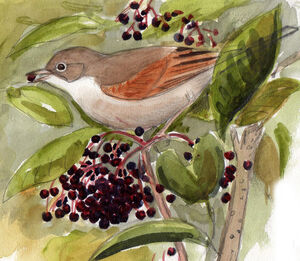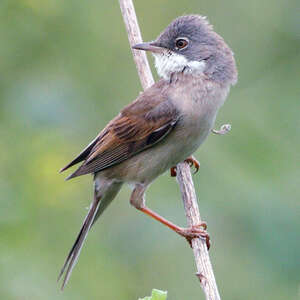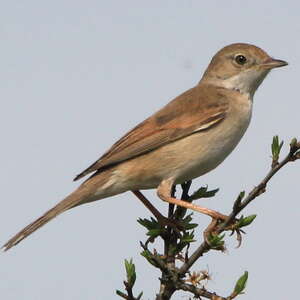Common Whitethroat
Curruca communis - Fauvette grisette
Identification
The Common Whitethroat is a medium-sized, slender warbler. The nominate subspecies from western Eurasia is easily recognizable by the light brown tones of its wings. This color is mainly present on the tertiaries, inner secondaries and large coverts, which are dark brown but with a wide outer edge of a chestnut color, the visible part of the feathers. The rest of the upper parts is of a rather warm medium-brown.
There is quite a marked sexual dimorphism. The breeding male has the top and sides of the head as well as the neck clearly light grey, with two white eye arcs circling the chestnut eyes. The white throat contrasts well with the grey cheeks, especially when puffed out when singing. The underparts are washed with a pinkish-grey, with the flanks lightly reddish. The undertail coverts are white. The beak is grey and light at the base. The legs are light, pink to rosy-brown.
The female is distinguished from the male by the absence of grey on the head, which is concolourous with the mantle. Some females, presumably older, gray slightly, but never as much as the male. Her eye is also slightly darker. The eye arcs are less evident. The underparts are washed with a light chamois, without pinkish tinge.
The juvenile resembles the female. It is distinguished by its new plumage of a slightly warmer russet-brown and its dark eye.
Four subspecies are described of which the nominative "communes" dealt with above. They differ from each other in details of coloration. For example, the ssp icterops in Anatolia and more eastern countries stands out for its more beige than chestnut wings.
The Common Whitethroat can be confused with the Spectacled Warbler, smaller, around the Mediterranean Sea. See the file of the latter.
Subspecific information 4 subspecies
- Curruca communis communis (Europe to n Turkey and n Africa)
- Curruca communis volgensis (se European Russia, w Siberia and n Kazakhstan)
- Curruca communis icterops (c Turkey to Turkmenistan and Iran)
- Curruca communis rubicola (mountains of c Asia)
Foreign names
- Fauvette grisette,
- Curruca zarcera,
- papa-amoras-comum,
- Dorngrasmücke,
- mezei poszáta,
- Grasmus,
- Sterpazzola,
- törnsångare,
- Tornsanger,
- penica obyčajná,
- pěnice hnědokřídlá,
- Tornsanger,
- pensaskerttu,
- Witkeelsanger,
- tallareta comuna,
- Þyrnisöngvari,
- cierniówka,
- brūnspārnu ķauķis,
- rjava penica,
- Серая славка,
- ノドジロムシクイ,
- 灰白喉林莺,
- törnsångare,
- 灰白喉林鶯,
Voice song and call
The song consists of a short, rushed phrase of 3 to 4 seconds, both melodious and grating, whose phrasing is unique to each male, but whose structure remains typical of the species. It can briefly evoke the beginning of the song of a Garden Warbler or, conversely, that of a Mediterranean Common Whitethroat. It often starts with the same syllables si tu.... The habitat of fallow land and overgrown scrubland can help with recognition.
A low, isolated djun can be understood as a cry of anxiety when entering the territory. In case of danger, it emits a nasal sequence wuitwuitwuitwuit... Both cries are typical. Occasionally, a sharp tec can be heard.
Habitat
Common Whitethroats occupy a wide variety of open habitats which are always well exposed. These are mainly uncultivated or fallow areas, with scattered low shrubs and bushes and a herbaceous context.
Behaviour character trait
The Common Whitethroat is a great migrant which will spend winter in Africa south of the Sahara. Its long migratory routes take time due to the stopovers to regain its strength.
Thus, it arrives rather late for the spring, in the second half of April and May.In its reproduction sites, it is a fast bird, always on the move, but would go unnoticed without its voice due to its dense habitat. Fortunately, the male sings often, perched conspicuously on a dominant stem or even in a brief nuptial flight, its white throat swollen and crown feathers bristling. Along the roads, sometimes he sings from an electrical wire or telephone. The female is much more discreet.
Flight
Dietfeeding habits
The diet of the Common Whitethroat is mainly insectivorous during breeding season. Insects are the majority, particularly Coleoptera, Hemiptera and Hymenoptera, but the scope is very wide and extends to other invertebrates such as spiders and even small mollusks.
The young are usually fed on less chitinous, therefore less tough, prey, like caterpillars of Lepidoptera or spiders.From summer the diet also becomes frugivorous and remains so during migration and stay in Africa. Small fruits are the most appreciated ones, e.g. the blackberries of the Rubus, the elderberries, the wild medlars, the cornel, etc. They are also interested in figs as they pass by.
Reproduction nesting
The Common Whitethroat is monogamous and territorial. The male, arriving first, chooses the territory and tries to attract a female with its song, which does not take long since the species is common.
The female quickly begins the construction of the very low nest in the vegetation from one of the male's drafts or not. He brings the building materials, all in a dry state, herbaceous twigs, grass leaves and other plants, all rather roughly accumulated and poorly fixed to the support, but the cut is well finished, lined with fine vegetable elements, rootlets and hairs. The female lays an average of 5 white eggs tinged with green and vaguely spotted with olive brown. The couple shares the incubation period of 12 days and the breeding at the nest for an equivalent time. The young will not be emancipated until 15 to 20 days later. In the south of the area, a second laying is possible.Geographic range
The breeding range of the Common Whitethroat is vast. It extends from temperate Europe, from the British Isles and Spain to Mongolia. It occupies only the south of Scandinavia, where the climate allows it. It rises little in altitude, hardly reaching 1500 m. The south of its range covers the Maghreb, Turkey, Lebanon and northern Israel, northern Iran, Central Asia and extreme northwest China.
The wintering range consists of a Sahelian strip from Senegal to Ethiopia and a second, larger east African band from the Red Sea to northern South Africa, extending as far as eastern Namibia. In short, the first concerns the birds of Europe and the second the Asian birds.
Threats - protection
IUCN conservation status
concern
in the Wild
threatened
evaluated
The Common Whitethroat species is not globally threatened and remains common. However, at the end of the last century, during the late 1960's and early 1970's, the populations in the western part of the continent decreased due to the drought in the Saharan region of West Africa, which was further aggravated by human activity.
In Europe, losses of habitats have been observed due to changes in the use of agricultrual land (intensification of practices, destruction of uncultivated margins, hedges, etc.). It can be concluded that the species is now certainly less common in Europe nowadays than it was 50 years ago.
Sources of information
- IOC World Bird List (v15.1), Gill, F and D Donsker (Eds). 2025-12-07.
- Les passereaux d'Europe, tome 2, P. Géroudet, M. Cuisin
- Sylvia warblers. Identification, taxonomy and phylogeny of the genus Sylvia, Shirihai H., Gargallo G. Helbig A. J.
- Birds of the World, The Cornell Lab of Ornithology
- Liste rouge européenne, LPO
- xeno-canto, Sharing bird sounds from around the world,
Other sources of interest
 Specification sheet created on
22/07/2023 by Jean François
Specification sheet created on
22/07/2023 by Jean FrançoisTranslation by AI Oiseaux.net
© 1996-2025 Oiseaux.net
- Accipitriformes
- Aegotheliformes
- Anseriformes
- Apodiformes
- Apterygiformes
- Bucerotiformes
- Caprimulgiformes
- Cariamiformes
- Casuariiformes
- Charadriiformes
- Ciconiiformes
- Coliiformes
- Columbiformes
- Coraciiformes
- Cuculiformes
- Eurypygiformes
- Falconiformes
- Galliformes
- Gaviiformes
- Gruiformes
- Leptosomiformes
- Mesitornithiformes
- Musophagiformes
- Nyctibiiformes
- Opisthocomiformes
- Otidiformes
- Passeriformes
- Pelecaniformes
- Phaethontiformes
- Phoenicopteriformes
- Piciformes
- Podargiformes
- Podicipediformes
- Procellariiformes
- Psittaciformes
- Pterocliformes
- Rheiformes
- Sphenisciformes
- Steatornithiformes
- Strigiformes
- Struthioniformes
- Suliformes
- Tinamiformes
- Trogoniformes


































